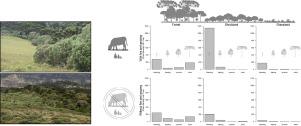Flora ( IF 1.9 ) Pub Date : 2021-05-26 , DOI: 10.1016/j.flora.2021.151853 Rafael Barbizan Sühs , Fernando Silva Rosa , Jonata Silveira , Nivaldo Peroni , Eduardo Luís Hettwer Giehl

|
Disturbances caused by land management via fire and cattle grazing can alter the population structure of keystone species that change the output of vegetation dynamics. Adult araucaria trees (Araucaria angustifolia) can facilitate the establishment of other woody plants and, thus, influence the expansion of forests over grasslands in the highlands of southern Brazil. Here we aimed to check araucaria population structure under two types of management – with or without fire and grazing– and in three habitat types: forests, shrublands and grasslands. We sampled araucaria populations in 40 transects (100×4 m), half of each located in the forest, and the other half, in variable extensions of shrublands or grasslands. Of the 40 transects, 18 were under management with fire and grazing and 22 in a protected area where the two disturbances are prevented (São Joaquim National Park). Overall, we sampled 339 araucaria seedlings, 59 saplings, 44 juveniles and 128 adults. Population structure differed both among habitats, between types of management, and between the same habitats but under distinct types of management. Population density was 1.4 times higher in areas with fire and grazing than without such disturbances, which was caused mostly by a larger number of seedlings. Under fire and grazing, we found 1.4 times more adults in forests, 5.7 times more seedlings in shrublands and 5.3 times more seedlings in the grassland than in the same habitat but without disturbances. Our results indicate that araucarias reach and germinate under all conditions but rarely surpass the seedling stage in grasslands and shrublands where fire and grazing is used. Consequently, fire and grazing disturbances should slow down forest expansion over shrublands and grasslands. In contrast, when disturbances are barred, araucarias can grow large enough to trigger their facilitative effect and then gear up the pace of forest expansion.
中文翻译:

火放牧对林草镶嵌中南洋杉种群结构的影响
由火灾和牲畜放牧引起的土地管理造成的干扰可能会改变主要物种的种群结构,从而改变植被动态的输出。成年南洋杉树 ( Araucaria angustifolia) 可以促进其他木本植物的建立,从而影响巴西南部高地草原上森林的扩张。在这里,我们旨在检查两种管理方式下的南洋杉种群结构 - 有或没有火和放牧 - 以及三种栖息地类型:森林,灌木丛和草原。我们在 40 个横断面 (100×4 m) 中对南洋杉种群进行了采样,每个断面中的一半位于森林中,另一半位于灌木地或草地的不同延伸区域。在这 40 个横断面中,18 个在用火和放牧进行管理,22 个在防止这两种干扰的保护区(圣若阿金国家公园)。总体而言,我们采样了 339 棵南洋杉幼苗、59 棵树苗、44 只幼树和 128 只成树。栖息地之间、管理类型之间、在相同的栖息地之间,但在不同类型的管理下。有火和放牧的地区的人口密度比没有干扰的地区高1.4倍,这主要是由大量的幼苗造成的。在火烧和放牧下,我们发现森林中的成虫数量是相同栖息地但没有干扰的情况下的1.4倍,灌木地中的幼苗数量增加了5.7倍,草地中的幼苗数量增加了5.3倍。我们的结果表明,南洋杉在所有条件下都能到达并发芽,但很少超过使用火和放牧的草原和灌木丛中的幼苗阶段。因此,火灾和放牧干扰应该会减缓灌木丛和草地上的森林扩张。相反,当干扰被禁止时,

























 京公网安备 11010802027423号
京公网安备 11010802027423号